We all know that outdoor air pollution can be harmful to our health. But did you know the air inside our homes can be a big problem too? Research by the World Health Organisation has found that indoor air quality can often be two to five times worse than outdoors.Fine particles in polluted air can travel deep into our lungs, causing irritation and inflammation. This increases the risk of asthma attacks, strokes, heart attacks, and other serious illnesses. Children, the elderly, and people with existing heart or respiratory conditions are particularly vulnerable to the effects of indoor air pollution. But since we spend about 90% of our time indoors – we could all benefit from cleaner air.
Indoor pollutants fall into three categories:
Asthma and allergy triggers - biological particles from mould, dust mites, pollen, smoke, and pet dandruff can cause allergic responses in some people. Mould most commonly affects bathrooms and poorly ventilated bedrooms, whereas dust mites and pet dandruff can lurk on floors, furniture and textiles.
Volatile Organic Compounds (VOCs) - these include both natural and synthetic chemicals, found in sources like cleaning products, air fresheners, paints, glues and adhesives, synthetic fragrances and cosmetics. Research has shown that VOCs can irritate the lungs, particularly in children.
Combustion Pollutants - these are the gases or particles that come from burning materials, such as fireplaces, space heaters, gas stoves, water heaters and tumble dryers. The amount and type of pollutants released depends on how well the appliance has been maintained, how well it’s ventilated and how it is fuelled. A few common combustion pollutants include carbon monoxide and nitrogen dioxide.
So how can you freshen the air in the home? Here’s a few simple changes you can make.
Have a shoes-off policy
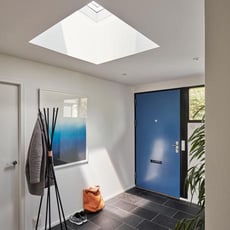 Your footwear can bring all kinds of unpleasantness into your home, from pesticides and pollen to dog mess and dust. Keep the outdoors out by taking your shoes off just inside the front door, or leaving them on the porch if you have one. Invest in a sturdy doormat to reduce the amount of dust and pollutants tracked inside.
Your footwear can bring all kinds of unpleasantness into your home, from pesticides and pollen to dog mess and dust. Keep the outdoors out by taking your shoes off just inside the front door, or leaving them on the porch if you have one. Invest in a sturdy doormat to reduce the amount of dust and pollutants tracked inside.
Asthma and allergy triggers - biological particles from mould, dust mites, pollen, smoke, and pet dandruff can cause allergic responses in some people. Mould most commonly affects bathrooms and poorly ventilated bedrooms, whereas dust mites and pet dandruff can lurk on floors, furniture and textiles.
Volatile Organic Compounds (VOCs) - these include both natural and synthetic chemicals, found in sources like cleaning products, air fresheners, paints, glues and adhesives, synthetic fragrances and cosmetics. Research has shown that VOCs can irritate the lungs, particularly in children.
Combustion Pollutants - these are the gases or particles that come from burning materials, such as fireplaces, space heaters, gas stoves, water heaters and tumble dryers. The amount and type of pollutants released depends on how well the appliance has been maintained, how well it’s ventilated and how it is fuelled. A few common combustion pollutants include carbon monoxide and nitrogen dioxide.
So how can you freshen the air in the home? Here’s a few simple changes you can make.
Have a shoes-off policy
 Your footwear can bring all kinds of unpleasantness into your home, from pesticides and pollen to dog mess and dust. Keep the outdoors out by taking your shoes off just inside the front door, or leaving them on the porch if you have one. Invest in a sturdy doormat to reduce the amount of dust and pollutants tracked inside.
Your footwear can bring all kinds of unpleasantness into your home, from pesticides and pollen to dog mess and dust. Keep the outdoors out by taking your shoes off just inside the front door, or leaving them on the porch if you have one. Invest in a sturdy doormat to reduce the amount of dust and pollutants tracked inside.
Let the fresh air in
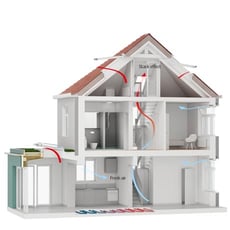
Good ventilation is the ultimate for cleaning the air indoors, plus it’s fast and free! Open the windows whenever you can, so fresh air can circulate throughout your home.The principle of ‘stack’ ventilation is a simple way to quickly and effectively ventilate your home without mechanical ventilation. This involves opening a window higher in your property, like a roof window, and lower window, to effectively ‘pull’ fresh air into the home. Hot air rises, being drawn out of the upper window, and fresh cooler air is pulled into the building to replace it. This is particularly effective if you have roof windows in a kitchen extension for instance, allowing you to quickly clear cooking smells and damp air. The same principle applies when you ventilate the whole house by opening both downstairs and upstairs windows and leaving internal doors open to allow air to circulate freely. Even if you can only manage a few minutes during the deepest depths of winter, it will makes a big difference.

Good ventilation is the ultimate for cleaning the air indoors, plus it’s fast and free! Open the windows whenever you can, so fresh air can circulate throughout your home.The principle of ‘stack’ ventilation is a simple way to quickly and effectively ventilate your home without mechanical ventilation. This involves opening a window higher in your property, like a roof window, and lower window, to effectively ‘pull’ fresh air into the home. Hot air rises, being drawn out of the upper window, and fresh cooler air is pulled into the building to replace it. This is particularly effective if you have roof windows in a kitchen extension for instance, allowing you to quickly clear cooking smells and damp air. The same principle applies when you ventilate the whole house by opening both downstairs and upstairs windows and leaving internal doors open to allow air to circulate freely. Even if you can only manage a few minutes during the deepest depths of winter, it will makes a big difference.
Stock up on indoor plants

Indoor plants are superb pollution-busters. As well as bringing life and colour to your home, they are natural air filters, absorbing harmful particles like benzene, formaldehyde and ammonia. The clever folks at NASA have compiled a list of the best air-cleaning plants, including peace lilies, spider plants, bamboo palms and weeping figs.
Groom your furry friends
 Pets are among the worst culprits for indoor air pollution, with hair and dead skin cells (known as pet dander) increasing the allergen levels. Groom your pets regularly to help reduce the amount of hair that ends up in the air and on the carpet and soft furnishings.
Pets are among the worst culprits for indoor air pollution, with hair and dead skin cells (known as pet dander) increasing the allergen levels. Groom your pets regularly to help reduce the amount of hair that ends up in the air and on the carpet and soft furnishings.

Indoor plants are superb pollution-busters. As well as bringing life and colour to your home, they are natural air filters, absorbing harmful particles like benzene, formaldehyde and ammonia. The clever folks at NASA have compiled a list of the best air-cleaning plants, including peace lilies, spider plants, bamboo palms and weeping figs.
Groom your furry friends
 Pets are among the worst culprits for indoor air pollution, with hair and dead skin cells (known as pet dander) increasing the allergen levels. Groom your pets regularly to help reduce the amount of hair that ends up in the air and on the carpet and soft furnishings.
Pets are among the worst culprits for indoor air pollution, with hair and dead skin cells (known as pet dander) increasing the allergen levels. Groom your pets regularly to help reduce the amount of hair that ends up in the air and on the carpet and soft furnishings.
Scrub that shower
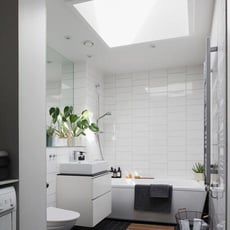
Mould can gather oh so quickly on shower tiles or on the dreaded plastic shower curtain. Clean regularly so those spores don’t have a chance to grow. Ensure the bathroom is well ventilated, as air that is too humid creates perfect conditions for mould and dust mites.
Keep a clean sheet
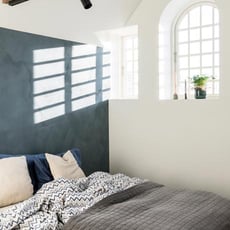
Dust mites love to hide in bedding, so wash bed linen once a week. If you suffer from allergies, use good quality dust-mite-proof pillows and mattress covers.
Flawless floors
Dust mites also like to hang out on carpets, so regularly hoovering is a must. Consider using a high efficiency particulate air (HEPA) vacuum cleaner with disposable bags and strong suction. The powerful filters trap both microscopic and large particles, so that they aren’t released into the air via the vacuum exhaust. It’s also a good idea to get a professional carpet cleaner in to clean the carpets now and then, to tackle any deep-lingering dust or spores that may have escaped the Hoover’s reach.
Use eco-friendly cleaning products
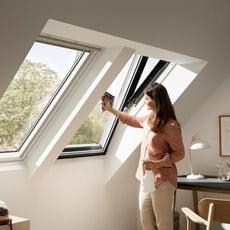
Many cleaning products can emit harmful VOCs and gases. There’s now a huge range of highly effective eco-friendly non-toxic cleaners on the market, or check out Pinterest for loads of ideas for making our own natural cleaning products. Prepare to be amazed by what can be achieved with just vinegar, bicarb soda and/or lemons!

Mould can gather oh so quickly on shower tiles or on the dreaded plastic shower curtain. Clean regularly so those spores don’t have a chance to grow. Ensure the bathroom is well ventilated, as air that is too humid creates perfect conditions for mould and dust mites.
Keep a clean sheet

Dust mites love to hide in bedding, so wash bed linen once a week. If you suffer from allergies, use good quality dust-mite-proof pillows and mattress covers.
Flawless floors
Dust mites also like to hang out on carpets, so regularly hoovering is a must. Consider using a high efficiency particulate air (HEPA) vacuum cleaner with disposable bags and strong suction. The powerful filters trap both microscopic and large particles, so that they aren’t released into the air via the vacuum exhaust. It’s also a good idea to get a professional carpet cleaner in to clean the carpets now and then, to tackle any deep-lingering dust or spores that may have escaped the Hoover’s reach.
Use eco-friendly cleaning products

Many cleaning products can emit harmful VOCs and gases. There’s now a huge range of highly effective eco-friendly non-toxic cleaners on the market, or check out Pinterest for loads of ideas for making our own natural cleaning products. Prepare to be amazed by what can be achieved with just vinegar, bicarb soda and/or lemons!
No comments:
Post a Comment